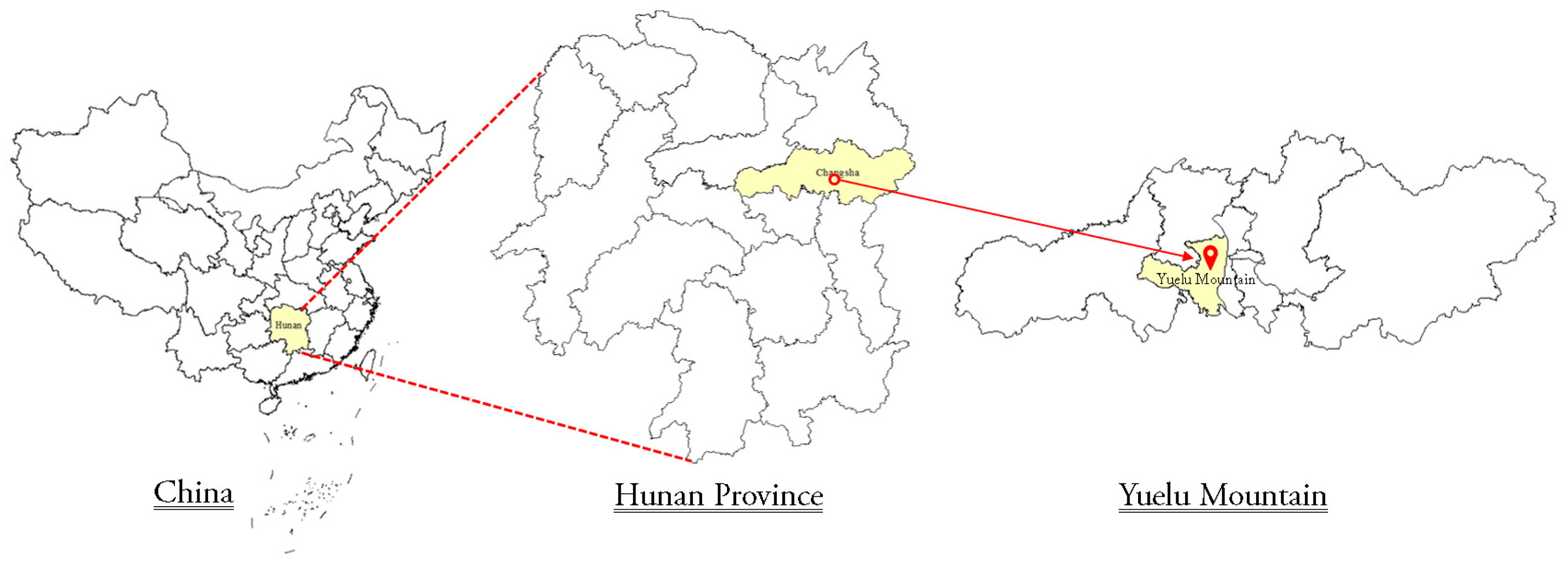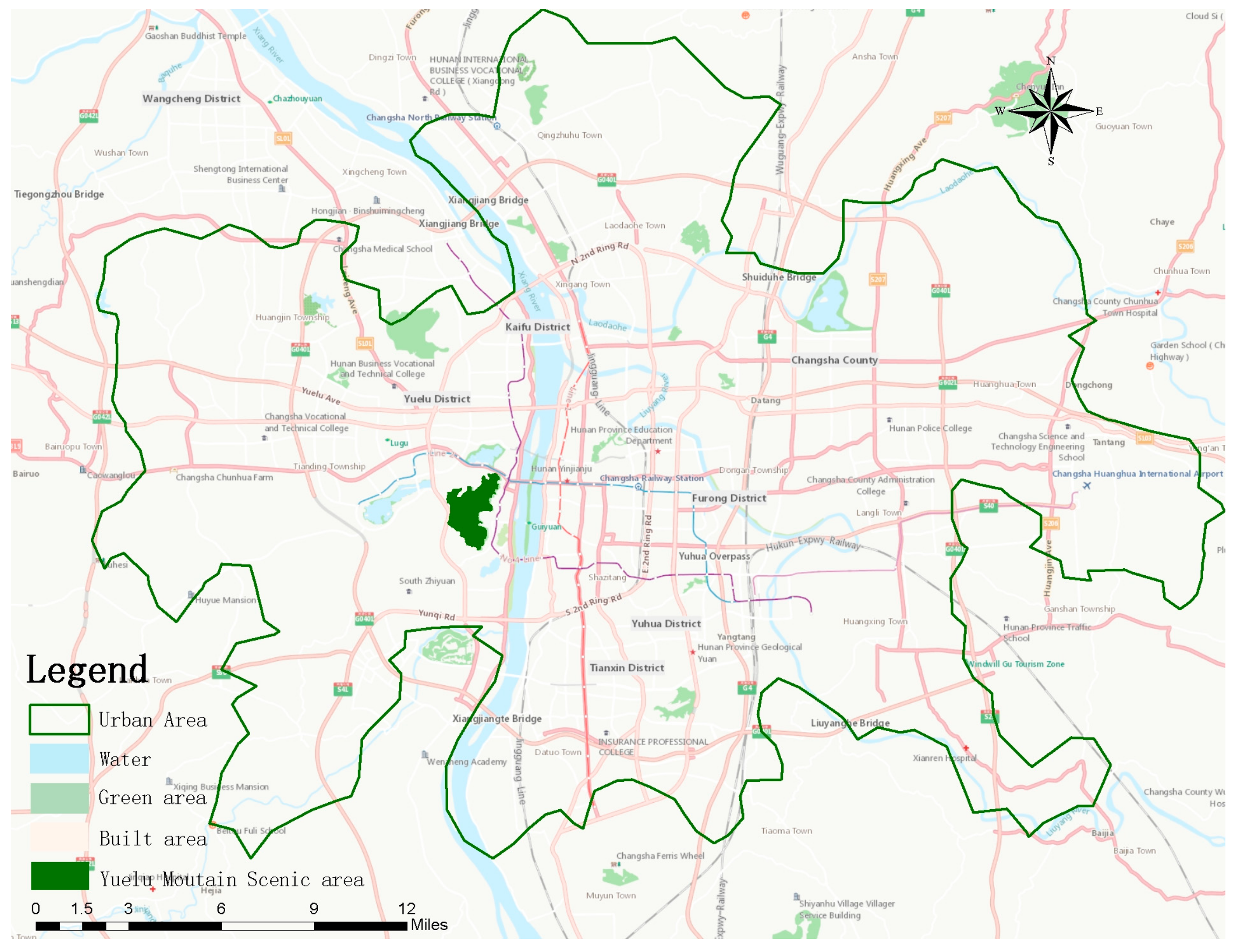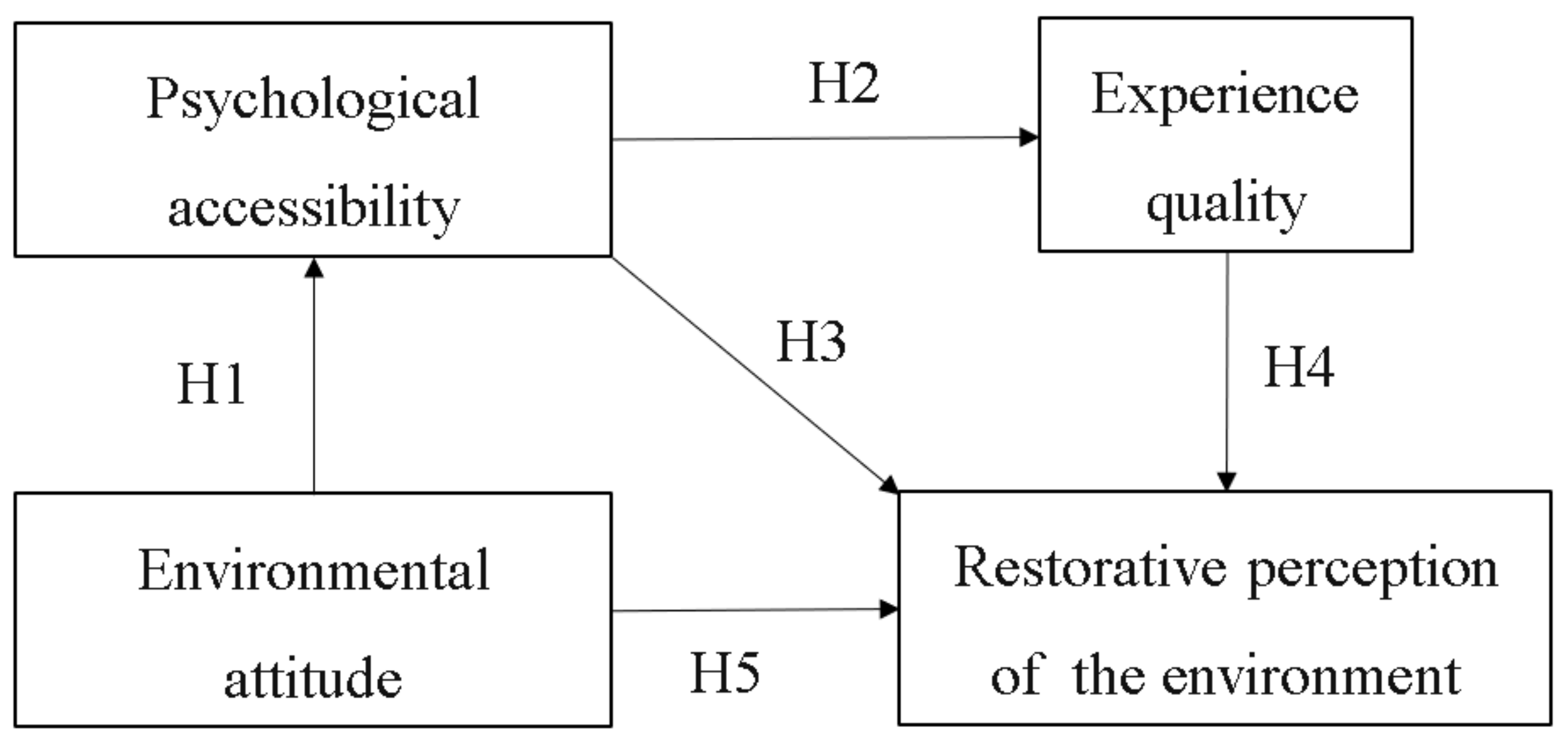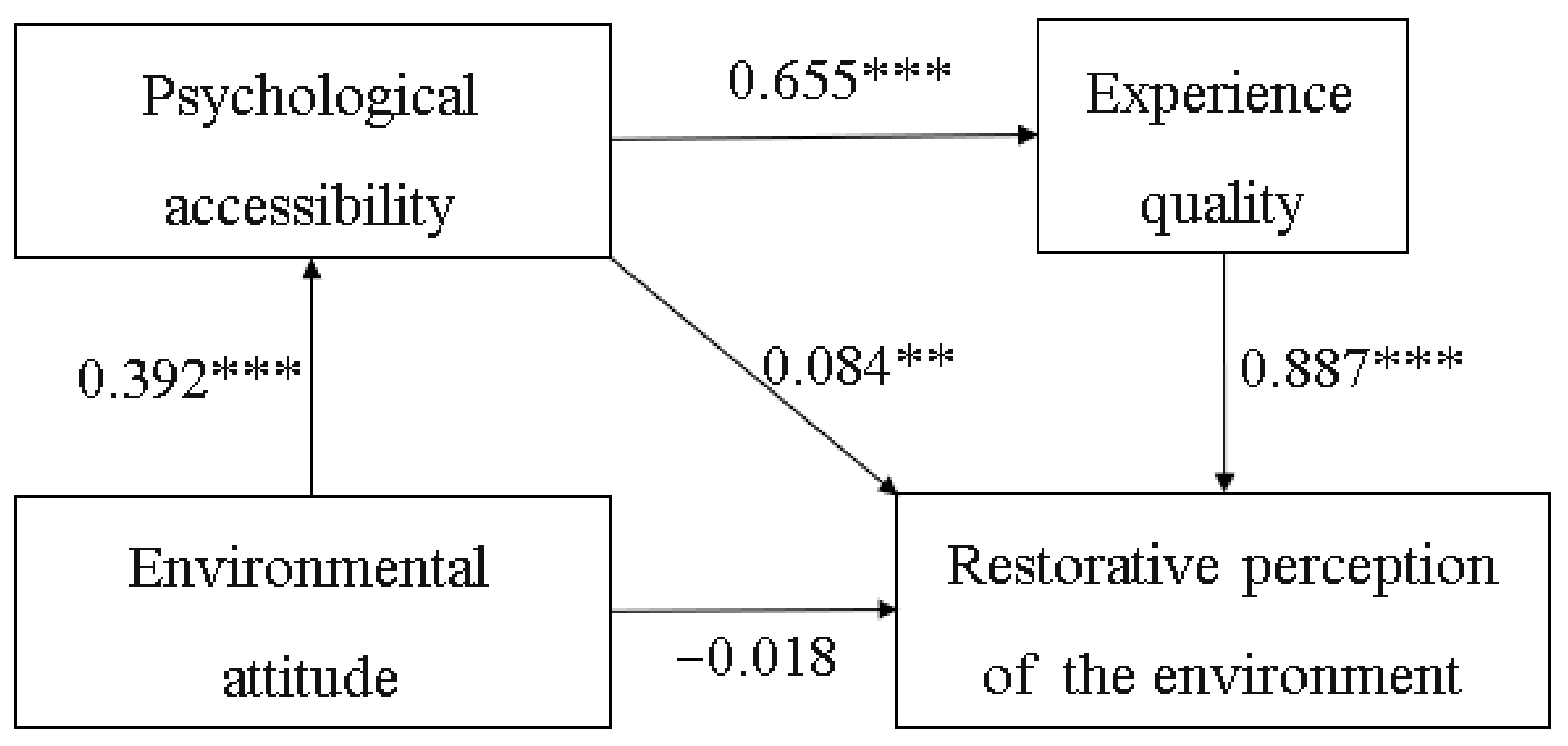1. Introduction
Due to economic development, globalization, urbanization, industrialization, and social progress, people’s standard of living has also improved. According to UN-Habitat, the proportion of the global urban population is expected to rise from 56% in 2021 to 68% in 2050, once again, posing challenges and opportunities for urban life [
1]. Spatially, cities are spreading from the center to the periphery, creating inextricable links between urban and neighboring areas for leisure and recreation. Land use forms, adapted to the needs of urban dwellers for short-term leisure and recreation, are constantly being emphasized and developed [
2]. However, development is also a double-edged sword. For example, with rapid development and progress, people have to deal with a lot of mental pressure in maintaining their survival. Many city dwellers are experiencing various physical and psychological problems as a result [
3,
4,
5]. At the same time, the outbreak of COVID-19 in 2020 has forced people to adapt to new lifestyles in many ways [
6,
7]. For example, a focus on the health benefits of green spaces in the living environment has been found to be conducive in improving public health in settlements in the post-pandemic era and positively intervening in people’s psychological crisis [
8]. As a major recreational space for urban residents, urban forests will play an important role in promoting the physical and mental health, and maintaining the social well-being of urban residents in the post-pandemic era. Therefore, healthy urban living will inevitably become the focus of attention in the post-pandemic era [
9].
Since the 20th century, the study of restorative environments has become one of the main focuses of scholarly work in the fields of environmental psychology, public health, and urban planning. The concept was first introduced in the field of environmental psychology, with Kaplan [
10] defining it as an environment that enables people to better recover from mental fatigue and stress, and Hartig [
11] further defining ‘restoration’ as the regaining of physiological, psychological, and social capacities that have been depleted in the process of adapting to the environment. It is clear that the study of restorative urban environments is an interdisciplinary field of research based on environmental psychology, with public health as its goal, and urban spatial design as its orientation.
The study of restorative perception includes the research of restorative effectors, effector objects and effector mechanisms [
12,
13,
14]. Recent studies in this field have shown that the restorative experiences offered by urban green spaces can influence the physical and mental health of urban dwellers in a positive way, helping improve mood and relieve mental stress [
14,
15,
16]. Furthermore, the study of restorative urban environment subjects focuses on the types of urban environments and environmental elements that have a potential restorative effect on the health of residents. For example, urban green spaces with a high degree of naturalness and safety are often more likely to induce restorative perceptions [
17,
18]. The study of the effect of the object of restoration focuses on the extent to which the restorative environment affects different groups of people physically and mentally. An example of this is looking at the restorative effects of restorative environments on different groups of urban residents [
19,
20,
21]. Some studies have shown that restorative environments may have better restorative effects on vulnerable groups such as the sick, women, children, and the elderly. These groups are usually more stressed and vulnerable to physical and mental fatigue in their daily lives than the general population. The mechanism of effect examines the interaction between the subject and the object, and explores the impact of different interacting factors on the operation of the mechanism. Herzele et al. [
22] found a positive impact of place memory on restorative effects. That is, the reasons people enter a landscape are rarely related to the color or shape of the place itself, but rather they do it to find similar perceptual experiences that they can get in the natural environment. Many other scholars have also explored the perception of restorative green spaces by looking for a general consensus of preference [
23] and a sense of attachment to a place [
24], and all have revealed that the interaction between individuals and their environment is significantly related to the restorative effects of the environment [
25].
There has been a growing awareness of the importance of urban green spaces, which has led to increased attention and demand for such areas [
26]. However, not all urban dwellers have access to pristine urban green spaces to pursue a higher quality of restorative perception experiences as they would like to in their daily lives. For the general public, the most accessible natural environment is the urban green space represented by urban forest parks [
4,
27]. However, the development of urban land is very limited and many of the available green spaces are not being used for their functions. This also means that we must change our mindset and not only focus on the quantity and size of urban parks alone, but also on the quality of the parks and improving the utilization of green spaces, as well as playing a key role in building a healthy urban life to truly meet people’s demands for green spaces [
28,
29,
30,
31]. Therefore, we must understand the psychological mechanisms behind people’s willingness to go to parks, in order to help people engage in recreational behavior more easily and quickly, to maximize the performance of urban parks. It is generally accepted that the higher the accessibility of a park, the greater its performance and the higher the health benefits to people. In fact, accessibility is a complex and flexible concept that has been interpreted in different ways across different fields and by different research subjects [
32,
33]. Some of the most widely used definitions are: the number of target objects that can be obtained or approached within a given spatial area [
34]; the ease of overcoming spatial resistance [
35]; and the potential for interaction between points in space [
36].
The value of an urban park is largely determined by how people use it, and whether people ‘want to use it’ depends on non-physical (i.e., psychological, perceptual, subjective, etc.) factors, such as satisfaction and the suitability of the facility to their needs [
37,
38]. In most studies, accessibility is measured by physical factors such as transport, type, size, and economics condition [
39]. Clearly, these studies do not reflect the perceptions of the general public, but perceptions and attitudes often influence their decisions [
40,
41], which in turn may influence the quality of their experience. According to Vaske and Donnelly [
42], as outlined in their cognitive hierarchy model of human behavior, the process of structuring people’s perceptions of the environment is divided into an inverted pyramid consisting of people’s values, value orientations, attitudes and norms, behavioral intentions, and behaviors [
43,
44]. Each element is layered on top of the other. Values provide the basis for attitudes and beliefs, which in turn influence the ultimate behavioral intentions and the experience of the actual behavior. In Ajzen’s theory of planned behavior (TPB) [
45], it is argued that behavioral intention is the most direct factor influencing behavior and that behavioral intention is in turn influenced by attitudes, subjective norms and perceived behavioral control. These theories significantly improve the explanatory and predictive power of research on behavior and argue that attitudes are the most central concept in the theory of planned behavior [
46]. Similarly, in the field of human–earth relations, there are complex pathways of influence among attitudes, beliefs and behaviors within people’s environmental awareness and pro-nature mentality. In this era of increasing human influence on the ecological environment, it is important to have a deeper understanding of how and why people value forest recreation. This can also enable forest park managers to take action to improve the social acceptance of forest recreation. Thus, people’s environmental attitudes and psychological factors should be considered in the planning and management of urban forest parks. This also reveals that the traditional study of park accessibility, which relies on physical distance measures, has major limitations from the perspective of activity selection. If positioned purely to enhance spatial accessibility at a macro scale, it may ultimately enhance the quality of physical elements of a system, such as accessibility to transportation, but may not maximize the psychological needs of people [
47,
48]. In studies of environmental restorative perceptions, the quality or characteristics of restorative environments are often investigated in relation to individual restorative perceptions, and the role of individual and social variables in psychological restoration is often overlooked [
49]. In order to improve the inclusiveness of urban green space recreation, we should understand users’ environmental attitudes, psychological accessibility, and their real experiential feelings [
50,
51]. In the field of leisure tourism, Otto and Ritchie [
52] also define the ‘quality of experience’ as an affective component of experience that includes subjective, emotional, and personal responses to various aspects of service development, ultimately leading to overall satisfaction [
52,
53]. In the context of tourism, service quality refers to the performance of services at the attribute level, while the quality of experience refers to the psychological outcome of a tourist’s participation in a tourism activity [
54], which is the cognitive–emotional state [
55] that an individual derives from the tourism experience.
Therefore, the main objective of this study is to investigate the relationship between psychological accessibility and environmental attitudes toward environmental restorative effects, and to understand users’ subjective perceptions and needs from a more microscopic perspective, through individual perception-based accessibility studies. This is important in order to provide an empirical basis for improving the spatial layout and utilization of parkland, to maximize the performance of urban green spaces and their restorative effects on people. We attempt to determine the impact of psychological accessibility on the restorative effects of the environment by answering two research questions: (1) Do people’s different attitudes toward the environment influence the level of psychological accessibility and the quality of experience? (2) Does the level of psychological accessibility influence the effectiveness of environmental resilience?
5. Discussion
This study seeks to uncover the pathways and mechanisms by which psychological accessibility affects environmental restorability. To this end, a model of environmental resilience under the influence of psychological accessibility is constructed. It specifically looks at environmental attitudes, quality of experience, and other relevant factors. This study contributes to the development of tourism-management literature related to the psychological accessibility of urban green spaces, and the findings support the study’s key hypothesis, implying that visitors’ psychological accessibility and quality of experience influence the effects of environmental restorability in urban green spaces. These findings also support the studies by Park [
66], Liu [
96], and Oriade [
74]. More positive environmental attitudes are more likely to have higher psychological accessibility to the destination, and therefore higher environmental restorative effects. While accessibility studies in China have mainly focused on transportation factors, such as calculation of shortest paths and evaluation of road network structures, this study strengthens the application and focus of accessibility between urban planning and social sciences by correlating psychological accessibility with perceptions of environmental restorability, including psychological, human and social non-transportation factors. Subsequently, practical suggestions and implications for the planning, design, and management of urban green spaces are presented.
According to the results of the data analysis, environmental attitudes, psychological accessibility, environmental quality, and perception of environmental resilience all have an impact, but environmental attitudes do not directly influence the perception of environmental resilience, but rather through psychological accessibility and experience quality. The following hypotheses were verified through the empirical analysis conducted in this study: the more positive the environmental attitude, the higher the psychological accessibility; the higher the psychological accessibility, the better the quality of the experience; the higher experience quality, the better the restorative perception of the environment, thus, the “environmental attitude—psychological accessibility—quality of experience—restorative perception of the environment” chain mediation pathway was verified. In addition, the full mediating effect of psychological accessibility and experience quality on restorative perception of the environment was also verified. This conceptual model leads to a pathway for environmental restorative perceptions in terms of psychological accessibility.
Environmental attitudes have a significant positive effect on psychological accessibility, in contrast to people’s perceptions of human rights, which has a greater effect on their environmental resilience. Each person has a different perception of nature, which is often used as a basis for action or inaction. We need to explore what urban green space really means to people through a better understanding of the relationship between humans and nature. By better understanding people’s psychological willingness to participate in green recreation activities, we can value the influence of psychological awareness on decision-making and management. This also validates Kellert’s [
108] view, stating that understanding how people perceive and experience the beauty of all landscapes is crucial to gaining public support and compliance with ecologically motivated landscape change. Effective management needs to be tailored to people’s real needs and interactions so that more people, including disadvantaged groups, can share the benefits of the environment, as well as providing a basis for planning and managing the construction and regeneration of green spaces in the areas surrounding urban parks [
109]. Understanding people’s perceived attitudes and improving their psychological accessibility is important to help maximize the “best use of things”.
It is undeniable that accessibility has a direct impact on the performance of urban green spaces and the quality of people’s experience. In this study, all dimensions of psychological accessibility had a significant positive impact on the quality of experience. Urban green spaces not only provide a comfortable and pleasant urban environment for citizens, but also provide an important input for the sustainable and healthy development of urban life. In addition to improving the physical environment of the space through physical means, more attention should be paid to stimulating the spatial vitality of an area, in order to improve psychological accessibility and the sense of place and attachment to the destination. This will contribute to increasing the effectiveness of learning, enjoyment, and temporary escape from the pressures of real life. On the basis of relevant policies, regulations and plans, the public is provided with a “bottom-up” platform [
110] to carry out interactive activities that deepen and improve the quality of experience and reflect the initiative of the public, making urban green spaces more functional and inviting to users.
The learning, enjoyment, and escape dimensions of the experience quality have a significant positive impact on being away, fascination, extent and compatibility in environmental restorative perceptions, i.e., higher experience quality helps people obtain better environmental restorative perceptions. According to attention restoration theory [
83], exposure to the outdoor environment is conducive to positive emotions and the restoration of directed attention mechanisms. In the interaction between people and their restorative environment, psychological recovery is not only related to the physical environment, but also to the interaction between the individual and the environment [
10]. It is easy to understand that the better the quality of the experience provided by an urban green space, the more the user feels a sense of freedom from the daily routine. The more they perceive the enchantment of the environment, the more the inclusion in the environment is conducive to the physical and psychological recovery of the visitor, the natural recovery of directed attention, and the acquisition of positive emotions [
111].
This paper finds that environmental attitudes do not directly influence the level of restorative perception, but must act through mediators, i.e., through psychological accessibility, and experience quality to ultimately influence the effect of restorative perception, which contradicts hypothesis H5. In fact, numerous factors have the potential to influence the quality of park use, and research on the relative importance of several of these factors remains somewhat inconsistent. In addition, there is a lack of widely adopted, integrated conceptual models and tools to model park use. This can be explained through a number of reasons. First, the NEP scale has been developed for a long time, and domestic scholars’ research on the reliability and validity of the NEP scale is basically the same as that of foreign studies, all agreeing that the NEP scale has good reliability and validity [
59], but there is still no agreement on the dimensions of the scale. Although there is no essential difference between scales with different numbers of questions, they can be tailored according to the study area [
112,
113] and research object [
114,
115], on the basis of ensuring the reliability and validity of the scale. However, it is indisputable that this situation may also affect the results of the empirical study to a certain extent. Second, while environmental attitudes focus more on the antecedents of psychological pathways, the effects of environmental restorative perceptions focus more on the effects after the implementation of driving mechanisms, so the influence of intermediate links cannot be ignored. The theory of planned behavior [
45], one of the leading behavioral theories in psychology, also indicates that cognitive structures (e.g., attitudes, beliefs, norms, and values) are good predictors of behavioral intentions, but there are many barriers between behavioral intentions and actual behavior. That is, attitudes largely and directly influence decision-making behavior, but may not directly influence the strength or weakness of the effects ultimately obtained.
The satisfactory fit between the model and the sample data in this study suggests that the model is applicable and effective in explaining and predicting people’s park use needs and behaviors. The relationship between people’s psychological perceptions and effectiveness is explained to a certain extent on the basis of the theory of planned behavior and the influencing factors investigated. Thus, our findings test the hypothesis that if a person has a positive attitude towards the environment and faces a better psychological accessibility to a destination, they are more likely to have the intention to visit the park for a recreational experience and obtain a higher environmental restorative effect. The results suggest that psychological accessibility is related to the perception of environmental restoratives, which is a new development, since existing theoretical perspectives on restorative environments prioritize bottom-up perceptual processing over general associations. Indeed, this finding is not without precedent, as researchers such as Lättman [
73], Wan [
116] and Nursyamsiah [
117], have hypothesized that psychologically generated accessibility, associations, and connections to a place may play a role in restorative perception. In addition to suggesting a greater role for psychological accessibility in theoretical models of restorative environments, these findings also have implications in the planning and management of urban green spaces.
In conclusion, these findings provide an exciting platform for further research into how individual psychological dimensions can enhance psychological restoration on-site. This suggests the importance of theoretical and practical applications of the study, to some extent guiding the way to improving the performance of green-space use.












